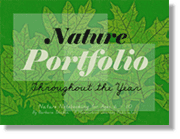
Riley's working on Nature Portfolio Throughout the Year by Barbara Shukin this year for science. Nature Portfolio is built on the idea of nature notebooking or journaling. The portfolio is divided into two sections including 48 student notebook pages covering 60 topics to study and the parent guide. The topics are broke down by seasons and biomes. For example, for fall, under September, October, and November are..
Yards and Gardens:
grasshoppers & crickets, mice, apples
Woods and Fields:
geese & ducks, wasps, nut trees
Ponds and Streams:
birds of prey, freshwater crustaceans, mosses & ferns
Desert Lands:
snakes, foxes, pines & pine cones
Along the Seashore:
sand crabs, sandpipers, sand worms
The parent guide gives you cut and paste images for the student pages, suggested writing assignments including narration ideas, copy work, and vocabulary, reproducible forms and lined pages for student pages, and a skeleton lesson plan with suggested books and resources to aid your study.
Some recommended resources are The Handbook of Nature Study by Anna Botsford Comstock, Fun with Nature: Take Along Guides, The Wonders of Nature Sketchbook by Colleen Monroe, Christian Liberty Nature Readers, as well as many other picture books.
We typically do science on Tuesdays and Thursdays. I read aloud information on the suggested topic and Riley completes a notebook page. We also go out and study the topic in nature if possible.
Here are some samples of her work....
Riley prefers drawing her own illustrations rather than cutting and pasting the images included. She also likes writing mini reports in addition to the copywork, and vocabulary.
I do have one complaint regarding Nature Portfolio. I removed the parent/teacher section from the binder so Riley could keep her notebook pages orderly. But now, because of way they're hole punched, these pages don't fit in a typical binder. Rather than re-punch pages and making holes in student work areas, I just have them loose in a file folder. This is not very handy. I wish the teacher pages were bound separately or created to be punched for a traditional binder.
Overall, Nature Portfolio is a good nature study program if you want something planned and laid out for you. This is not typically our nature as I like to plan. However, we needed this option this year. As you may have noted from former posts, science is not my forte and with all we have going on right now, we chose this in an effort to simplify.






Thanks for the info. I've been eyeballing their Nature portfolio and the History portfolios for a while, but the shipping is horrifying to Canada so I've been procrastinating.
ReplyDeleteIt does look from your description like maybe I should just bite the bullet and get them, though.
You're welcome Eddie. Just wanted to mention that I bought ours through Rainbow Resource. They had the best price and they are currently running a sale with free shipping for any order over $50. I'm not sure what their rate for Canada would be.
ReplyDeleteAnother option, just read picture books about animals, plants, and other nature things. Then have your student look up 3-4 vocab words, add some copy work, write a report, and illustrate a scene. Do this a couple of days a week and you'll have a similar experience.
If you do decide to go with the Nature Portfolio, don't be afraid to substitute books if need be. We are finding most of the books at the library, but today we were disappointed when we were supposed to be studying "animal tracks" and the book was titled Animals in Winter. It was very childish and had no mention of animal tracks. Thankfully, I had a Jim Arnosky book on our shelf that we substituted. I highly recommend it. The book was called Book of Animal Tracks and Wildlife Signs. The kids loved it!
Blessings,
Melissa